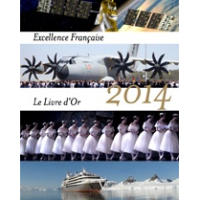
The sixth annual pat-on-the-back to France’s international influence and ambitions, known as the Excellence Française ceremony, was less star-studded and less eloquent than in previous years but nonetheless brought out a bright crop of CEOs, company presidents and military/defense personalities.
A string quartet of the Republican Guard set the tone for an evening of lilting pleasantness before the audience took place in the Grand Salon (former Counsel Room) of the Invalides, the vast complex built under Louis XIV to care for wounded soldiers. Louis the Great himself stood at the head of the room in full royal drapery, sporting big hair and surrounded by the symbols of the Sun King, watching over the ceremony with weary approval. Emperor Napoleon III witnessed the ceremony from the back of the room while several generals and field marshals looked on from the side at this made-for-TV ceremony.
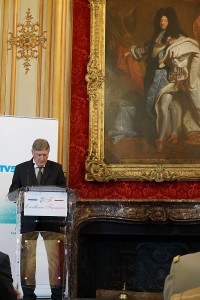
Maurice Tasler, president of Excellence Française, told the audience that French savoir-faire is recognized (reconnu) throughout the world but not sufficiently known (connu). He emphasized the importance of reinforcing the links between Excellence Française members who can help each other “in the spirit of mutual assistance and influence,” whatever their sector of activity may be. Each year, eight or more new members (individuals and entities) join an expanding circle of “mutual assistance and influence” called the Cercle de l’Excellence Française.
Beyond the ceremony’s naturalpraise of French products, talent and savoir-faire, it was Tasler’s expression “mutual assistance and influence” that scented the room for this writer, reawakening a sense of the mystery about the organization and its founders noted in this report of the 2012 ceremony.
Excellence Francaise is a non-profit organization working in conjunction with the company Tasler International.

How are members selected?
Sponsored by previously admitted members, then preselected, candidates pay a fee to the Excellence Francaise organization in order to gain admission to the group of 73 individuals and 62 member companies, associations, organizations and institutions. It’s therefore an honor for which one pays an admission fee or droit d’entrée, like entering an exclusive country club. (A request for further information about the droit d’entrée was denied.)
Since the mutual interests of Tasler International and Excellence Française in promoting French companies and goods clearly merge with those of the state, the ceremony took place under the patronage of the French ministers of foreign affairs, defense and the economy.
Intended especially for broadcast overseas, the event was filmed by TV5 Monde, a major partner of the Excellence Française organization, to be broadcast in 14 foreign languages. TV presenter Philippe Dessaint served as discreet master of ceremonies. Honorees and members receive a copy of the Excellence Française yearbook (cover image at top of this article). The full ceremony can be seen here.
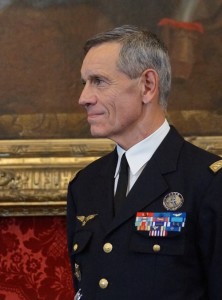
Anne-Marie Descôtes, director of globalization, development and partnership with the Ministry of Foreign Affairs and International Development, and member of the Excellence Française since 2012 when she was admitted as then-Director of the Agency for French Teaching Abroad, read a letter from Foreign Minister Laurent Fabius arguing for the multi-faced notion of the Foreign Ministry, including economic development.
Special recognition was then given to the Mission for the Centenary of the First World War. France’s role in NATO was also honored in the category Defense Sector. In accepting that honor, General Jean-Paul Paloméros, NATO’s Supreme Allied Commander Transformation, made special note of “the courage” of those who worked to reintegrate France into the organization in 2009.
The speeches: from complicity to beauty
Despite a current of gracious tutoiement on the podium as members of the class of 2013 passed the baton to those of the class of 2014, absent this year was the friendly banter that previously came from the unexpected encounter of two members representing different sectors. The speeches were not as lofty those of the two previous years attended by this writer. Had the most famous and prestigious of France’s companies already joined the Excellence Française club? Was this year’s crop simply not as articulate? Or was there already too much corporate complicity between members present to add any unforeseen charm to the conversation?
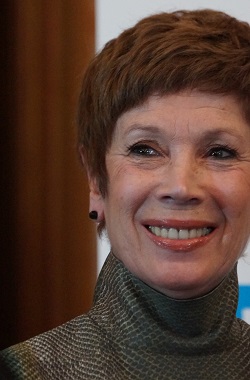
At times, the mix of corporate politeness and mutual salesmanship turned what could have been a celebration into a dry ritual. And so when Alexandre de Juniac, the director of Air France-KLM, surrounded by uniformed employees, praised the work of Augustin de Romanet, the president of the Paris airport authority, Aéroports de Paris, and vice versa, with both noting the importance of attracting the growing Chinese middle class, the discourses failed to take flight. Similarly when Patrice Piveteau of Cognac Frapin passed the flame in the Wine and Spirits Sector to Valérie Rousselle, president of Château Roubine, who spoke of the virtues of rosés from Provence. Absent were the subtleties and good humor heard in 2012 with the welcoming of Louis-Marc Chevignard, Grand Connétable of the Confrérie des Chevaliers de Tastevin, Burgundy’s famous wine brotherhood.
Nevertheless, the event was not without earnest elegance, as when Brigitte Lefèvre accepted the honor on behalf of the National Ballet of the Paris Opera. “Why do we dance?” she said, “… Why do we defend France? For beauty… The world is beautiful… Not simply because it’s beautiful but because we work at it.”
What constitutes French excellence?
In addition to the major categories it honors, Excellence Française has taken to celebrating each year a special category of French accomplishment. Last year that category was the arts, with a stellar podium including Jean-Luc Ponty (jazz violinist), Bernard Lavier (visual artist), Sarah Moon (photographer), Philippe Starck (designer), Marie-Agnès Gillot (classical dancer), Lou Diollon (pop singer-songwriter), Michel Bouquet (actor), Albert Urdozo (comic book writer), Natalie Dessay (lyrical singer). Edgar Moreau (classical cellist) was unable to attend.
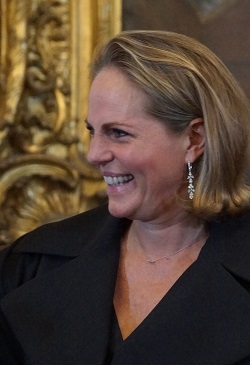
Among that evening’s most interesting comments were those that attempted to define French excellence. Philippe Starck noted that to be French is “to be European of French origin.” Natalie Dessay, citing the presence of her parents in the audience, remarked that it’s they who best represent French excellence (“C’est eux l’excellence française)”. Actor Michel Bouquet chose to “offer silence” as his comment on the question. The artists scored points for drama and humor, yet it was Yann Callère, director of the Sofitel group, representing the Luxury Hotel Sector, who astutely observed last year that French excellence is also conveyed internationally “by people who aren’t French.”
There was little such analysis this year, though Ariane de Rothschild, vice president of Edmonde de Rothschild Holding, in entering the class of 2014 in the Banking Sector, said that she associated excellence with passion, engagement (philanthropically and socially), reinvention, risk-taking and competitiveness. She saw membership as a sign of encouragement in the face of French bashing and bank bashing. Yet she seemed to recognize that not all of the bashing is undeserving and coming from without. “France is going through a slight slump (passage à vide) that I regret a lot,” she said, “because France is an extremely competitive country that doesn’t have to be intimidated by the rest of the world.”
Innovation: the American model
When Francophiles abroad profess their love for France they rarely mention an admiration for its technological innovation or entrepreneurial prowess. One of the objectives of Excellence Française is to change that perception. Therefore, “innovation” was honored as this year’s special category with eight relatively young companies joining the class of 2014.
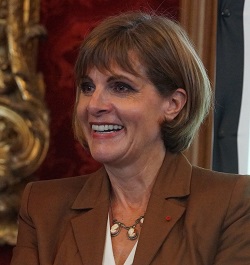
“It’s necessary for small fish to be able to become big fish,” said Anne Lauvergeon in introducing the innovators. “And small fish becoming big fish, that’s the American model… I think we’re in the process of beginning to get there.” Lauvergeon was inducted as a member in 2010 when she was CEO of the nuclear energy company Areva, and now president of the French commission Innovation 2030.
The eight, mostly small-fish companies applauded for their innovation this year and represented at the ceremony by their CEOs or presidents were Sigfox (cellular connectivity), Nawa Technologies (organized nanostructures), Ennesys (energy technology), Withings (consumer electronics), Mauna Kea Technologies (medical imaging), Snips (data technology), Blue Frog Robotics (robotics) and KissKissBankBank (crowdfunding).
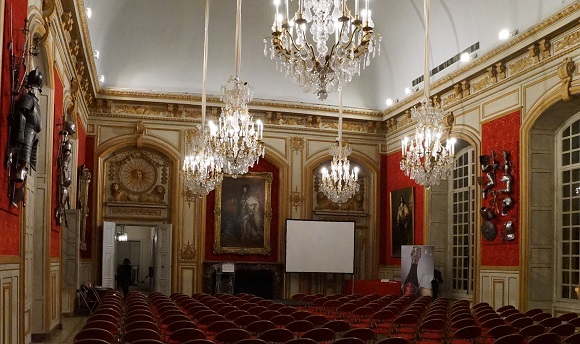
No awards ceremony is without its occasional miscue. This year’s most notable off-note took the form of an ad banner for a brand of champagne that was placed toward the right edge of our view (though not seen in the filming of the event). It was as though someone had forgotten to take the banner down from a private corporate event the previous evening. But the promo was indeed scheduled for this evening.
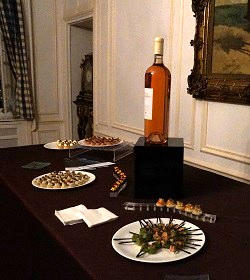 That brand of champagne and the rosé that had been celebrated during the ceremony were offered in abundance at the reception afterwards, yet the canapés and sweets were surprisingly spare. After an evening in which French gastronomy was so frequently lauded in speeches as one of the most internationally recognized forms of French excellence, it scant representation at the reception was glaring—not simply to journalists, who aren’t immune to the pleasures of endless champagne and filling reception fare, but apparently to hungry honorees and their sharp-elbowed guests.
That brand of champagne and the rosé that had been celebrated during the ceremony were offered in abundance at the reception afterwards, yet the canapés and sweets were surprisingly spare. After an evening in which French gastronomy was so frequently lauded in speeches as one of the most internationally recognized forms of French excellence, it scant representation at the reception was glaring—not simply to journalists, who aren’t immune to the pleasures of endless champagne and filling reception fare, but apparently to hungry honorees and their sharp-elbowed guests.
Honoring a chef would not only be entirely in keeping with the spirit of the evening but would likely allow for a more fitting reception. After more than three hours in polite company an evening, including a two-hour ceremony sparkling with superlatives and advancement of French enterprise, the final impression of watching guests descend upon a lonely plate of macaroons at 9:30 p.m. is not what one wishes to have in mind when thinking of French excellence.
Text © Gary Lee Kraut, 2014
Photos © Henri Martin, 2014

